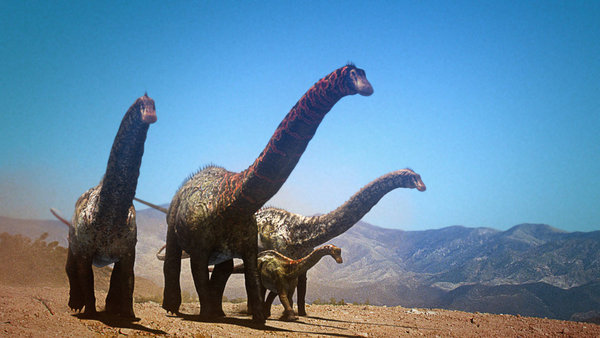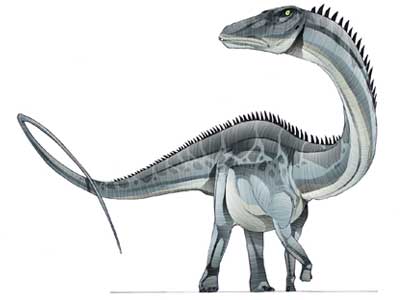Post by dinosauria101 on May 11, 2019 10:04:54 GMT 5
Dinhierosaurus lourinhanensis

Temporal range: Late Jurassic, Kimmeridgian
Scientific Classification
Kingdom: Animalia
Phylum: Chordata
Subphylum: Vertebrata
Clade: Sauropsida
Clade: Diapsida
Clade: Archosauromorpha
Clade: Archosauria
Clade: Dinosauromorpha
Clade: Dinosauria
Clade: Saurischia
Clade: Eusaurischia
Clade: Sauropodomorpha
Clade: Plateosauria
Clade: Massopoda
Clade: Anchisauria
Clade: Sauropoda
Clade: Gravisauria
Clade: Eusauropoda
Clade: Neosauropoda
Clade: Diplodocoidea
Clade: Flagellicaudata
Family: Diplodocidae
Subfamily: Diplodocinae
Genus:Dinheirosaurus
Species:Dinheirosaurus lourinhanensis
Size
Length: 26 meters?
Mass: 15-20 metric tonnes?
Etymology: Reptile from Porto Dinheiro of Lourinha
Dinheirosaurus is a genus of diplodocid sauropod dinosaur. Its remains were found in the upper section (Kimmeridgian) of the Late Jurassic strata of the Camadas de Alcobaça Formation located in central-western Portugal at Porto Dinheiro, Lourinhã. The fossils were described in 1999 by Bonaparte and Mateus, after excavations that lasted from 1987, the year of its discovery, to 1992.
The material found was at first referred to the previously described and coeval genus Lourinhasaurus due to perceived similarities. Later analysis revealed the fossil to be a different kind of sauropod and was thus described as Dinheirosaurus. The two genera were for some time still regarded as possible synonyms but further interpretation of both finds left no doubt of their independent status.
The type species is D. lourinhanensis, named for the town of Lourinhã.
Material
The fossil remains consist of a partial skeleton (the holotype, ML 414) of which the well-preserved articulated dorsal vertebrae are notable. The material also includes 12 dorsal ribs and fragmented limb bones. Dinheirosaurus lourinhanensis is characterized by its Diplodocus-like vertebrae with bifurcated neural spines that have different proportions when compared to Diplodocus. Also present is an accessory interverterbral articulation provided by structures derived from the hyposphene.
Systematics
These characteristics may indicate that D. lourinhanensis is derived from a more primitive diplodocid than Diplodocus, having evolved in the isolation of islands, as was the case with the Iberian Peninsula at the time, separated from the North American and European mainland.


Temporal range: Late Jurassic, Kimmeridgian
Scientific Classification
Kingdom: Animalia
Phylum: Chordata
Subphylum: Vertebrata
Clade: Sauropsida
Clade: Diapsida
Clade: Archosauromorpha
Clade: Archosauria
Clade: Dinosauromorpha
Clade: Dinosauria
Clade: Saurischia
Clade: Eusaurischia
Clade: Sauropodomorpha
Clade: Plateosauria
Clade: Massopoda
Clade: Anchisauria
Clade: Sauropoda
Clade: Gravisauria
Clade: Eusauropoda
Clade: Neosauropoda
Clade: Diplodocoidea
Clade: Flagellicaudata
Family: Diplodocidae
Subfamily: Diplodocinae
Genus:Dinheirosaurus
Species:Dinheirosaurus lourinhanensis
Size
Length: 26 meters?
Mass: 15-20 metric tonnes?
Etymology: Reptile from Porto Dinheiro of Lourinha
Dinheirosaurus is a genus of diplodocid sauropod dinosaur. Its remains were found in the upper section (Kimmeridgian) of the Late Jurassic strata of the Camadas de Alcobaça Formation located in central-western Portugal at Porto Dinheiro, Lourinhã. The fossils were described in 1999 by Bonaparte and Mateus, after excavations that lasted from 1987, the year of its discovery, to 1992.
The material found was at first referred to the previously described and coeval genus Lourinhasaurus due to perceived similarities. Later analysis revealed the fossil to be a different kind of sauropod and was thus described as Dinheirosaurus. The two genera were for some time still regarded as possible synonyms but further interpretation of both finds left no doubt of their independent status.
The type species is D. lourinhanensis, named for the town of Lourinhã.
Material
The fossil remains consist of a partial skeleton (the holotype, ML 414) of which the well-preserved articulated dorsal vertebrae are notable. The material also includes 12 dorsal ribs and fragmented limb bones. Dinheirosaurus lourinhanensis is characterized by its Diplodocus-like vertebrae with bifurcated neural spines that have different proportions when compared to Diplodocus. Also present is an accessory interverterbral articulation provided by structures derived from the hyposphene.
Systematics
These characteristics may indicate that D. lourinhanensis is derived from a more primitive diplodocid than Diplodocus, having evolved in the isolation of islands, as was the case with the Iberian Peninsula at the time, separated from the North American and European mainland.



